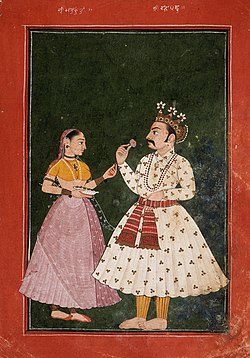Pandu
This article needs additional citations for verification. (March 2018) |
| Pandu | |
|---|---|
 A late 17th-century painting of Pandu and Kunti from Kashmir | |
| Personal Information | |
| Affiliation | Kuru dynasty |
| Weapon | Bow and arrow |
| Family | Parents see Niyoga
|
| Spouses | |
| Children | Sons from Kunti
|
| Relatives | Half-Cousins see Niyoga
|
In the Hindu epic Mahabharata, Pandu (Sanskrit: पाण्डु, romanized: Pāṇḍu, lit. 'pale') was a king of Kuru Kingdom. He is the father of the five Pandava brothers, who were actually gifted by different gods due to his inability of having children following Maharisi Kindam's curse.
Birth[edit]
When Vichitravirya died of having sickness, Bhishma unable to take the throne because of his vow, and Bahlika's line unwilling to leave the Bahlika Kingdom, there was a succession crisis in Hastinapur. Satyavati then invited her son Vyasa to impregnate the queens Ambika and Ambalika under the Niyoga practice. When Vyasa approached Ambalika, she was frightened by his scary appearance, she had become pale in disgust; hence, her son was born pale. Thus Pandu's name means pale.[1]
Reign and marriage[edit]
Pandu was taught in the fields of archery, politics, administration and religion by Bhishma. He was an excellent archer and Maharathi (warrior). He became the successor to his kingdom and was crowned King of the Kuru Kingdom. He was married to Kunti, the adoptive daughter of Kuntibhoja and the daughter of Shurasena (father of Vasudeva Anakadundubhi and grandfather of Krishna). His second wife was the princess of the Madra kingdom Madri. The marriage was proposed by Bhishma.[2] Pandu later conquered the territories of the Sindhu Kingdom, Kashi, Anga, Trigarta Kingdom, Kalinga, Magadha, etc., and thus re-established their supremacy over all the kings and increased the span of his empire.[3]
Kindama's Curse[edit]
Template:Plain image with caption While hunting in a forest (looking from a distance, his vision partially obscured by plants and trees), Pandu saw a couple of deer in the process of coitus, and shot arrows at them; only to find out that it was Rishi Kindama and his wife who were making love in the form of deer. The dying sage placed a curse on Pandu since he had not only killed them in the midst of lovemaking but was not remorseful for his action. King Pandu argued with sage Kindama by misquoting sage Agastya's ruling on the right of Kshatriyas' on hunting. Sage Kindama then cursed Pandu, the curse being that was he to approach his wives with the intent of making love, he would die.[4]
Exile and death[edit]
Upset and seeking to repent his action, Pandu handed his kingdom to Dhritarashtra and went for exile in forest. There, he lived as an ascetic with his wives.[5]
Birth of Pandu's sons[edit]
One day Pandu was telling his birth story and wish of becoming a father to Kunti. Kunti mentioned her mantra given by sage Durvasa. Pandu was overjoyed and told Kunti to use it to get a son from a suitable god. He wanted his son to be righteous, so he suggested Dharmaraja, the god of Death and Righteousness. Kunti used her mantra and the god granted her Yudhishthira. Later Pandu expressed his desire for a powerful son. This time Kunti called Vayu and Bhima was born. Later Pandu suggested Kunti invoke Indra and a skillful son, Arjuna was born. Pandu felt badly for Madri and he requested Kunti to share her mantra. Kunti shared her mantra once and Madri invoked Ashvins, and then gave birth to Nakula and Sahadeva.[6]
Death[edit]
One day, Pandu forgot about this curse and suddenly filled with lust for Madri and proceeded to have sexual act with her. After the act, his curse fulfilled and he died. His body was cremated in the forest itself. In grief that her husband died because of her, Madri committed suicide (possibly through self-immolation) after handing her children to Kunti.[7]
See also[edit]
References[edit]
- ↑ "The Mahabharata, Book 1: Adi Parva: Sambhava Parva: Section CVI". www.sacred-texts.com. Retrieved 31 August 2020.
- ↑ Debalina (20 December 2019). Into the Myths: A Realistic Approach Towards Mythology and Epic. Partridge Publishing. ISBN 978-1-5437-0576-8.
- ↑ Menon, [translated by] Ramesh (2006). The Mahabharata : a modern rendering. New York: iUniverse, Inc. ISBN 9780595401871.
- ↑ Ramankutty, P.V. (1999). Curse as a motif in the Mahābhārata (1. ed.). Delhi: Nag Publishers. ISBN 9788170814320.
- ↑ Ramankutty, P.V. (1999). Curse as a motif in the Mahābhārata (1. ed.). Delhi: Nag Publishers. ISBN 9788170814320.
- ↑ "The five pandavas and the story of their birth". aumamen.com. Retrieved 31 August 2020.
- ↑ Fang, Liaw Yock (2013). A History of Classical Malay Literature. Institute of Southeast Asian. ISBN 978-981-4459-88-4.

